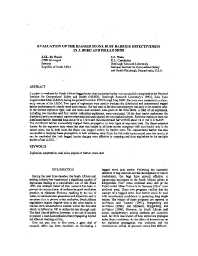Mining Publication: Evaluation of the Bagged Stone Dust Barrier Effectiveness in a Bord and Pillar Mine
Original creation date: June 2001
A project to evaluate the South African bagged stone dust explosion barrier was successfully completed at the National Institute for Occupational Safety and Health (NIOSH), Pittsburgh Research Laboratory's (PRL), Lake Lynn Experimental Mine (LLEM) during the period November 1999 through May 2000. The tests were conducted in a three-entry section of the LLEM. Two types of explosions were used to evaluate the distributed and concentrated bagged barrier performance in a multi-entry mine section. The fuel zone of the first explosion type was only in the center B-drift. In the second explosion type, coal and stone dust mixtures were placed in all three drifts. A total of six explosions, including two baseline and four barrier evaluation explosions, were conducted. Of the four barrier explosions, the distributed and concentrated barriers were each evaluated against the two explosion types. For these explosion tests, the distributed barrier extended from about 74 to 170 m and the concentrated barrier from about 74 to 104m in B-drift. The distributed barrier successfully stopped flame propagation in both types of explosion tests. The flame extended further for the explosion tests where the dust was loaded in all three entries compared with dust loaded only in the center entry, but in both cases the flame was stopped within the barrier zone. The concentrated barrier was also successful in stopping flame propagation in both explosion tests. From the full-scale experimental mine test results, it can be concluded both bagged barrier designs were effective in stopping coal dust explosions in the multiple entries of the LLEM.
Authors: JJ du Plessis, ES Weiss, KL Cashdollar
Conference Paper - June 2001
NIOSHTIC2 Number: 20021296
Proceedings of the Seventh International Mine Ventilation Congress, Wasilewski S, ed. (June 17-22, 2001, Crakow, Poland), chapter 81, :573-580
See Also
- Coal Dust Explosibility Meter Evaluation and Recommendations for Application
- Coal-Dust Explosion Tests in the Experimental Mine 1919 to 1924, Inclusive
- Experimental and Modeling Investigation of the Effect of Ventilation on Smoke Rollback in a Mine Entry
- The Explosibility of Coal Dust
- Inflatable Partitions for High-Expansion Foam Generators
- Mine Fires - Measuring the Efficacy of Gas-Enhanced Foam
- Mitigating Coal Dust Explosions in Modern Underground Coal Mines
- Refuge Chamber Expectations Training - 1.0
- Rock Dusting Considerations in Underground Coal Mines
- Technology News 515 - Float Coal Dust Explosion Hazards
- Page last reviewed: 9/21/2012
- Page last updated: 9/21/2012
- Content source: National Institute for Occupational Safety and Health, Mining Program


 ShareCompartir
ShareCompartir
